To enhance your rotational strength for better sports performance, focus on strengthening your core muscles. Incorporate exercises like planks, medicine ball twists, and Russian twists to build stability and power. It's also essential to engage hip and shoulder muscles for ideal movement efficiency. Always maintain proper form and warm up to prevent injuries. Stay tuned for more tips on integrating rotational movements into your training routine and tracking your progress effectively.
Understanding Rotational Strength and Its Importance in Sports
Rotational strength is a key component of athletic performance, influencing how effectively you can generate power and control during dynamic movements. Whether you're swinging a bat, throwing a ball, or executing a perfect golf swing, the ability to rotate your body efficiently can make all the difference. It's not just about brute strength; it's about harnessing your body's natural mechanics to achieve fluidity and precision.
When you develop your rotational strength, you're not just enhancing your athletic skills; you're also releasing yourself from limitations that hold you back. You'll notice improved agility, balance, and coordination, allowing you to move more freely and confidently in your sport. As you cultivate this strength, you'll find that your performance elevates, giving you the freedom to express yourself and push your limits. Embrace the journey of enhancing your rotational strength, and unleash your full athletic potential. A strong core also reduces injury risk by supporting the spine during exertion, further enhancing your performance.
Key Muscle Groups Involved in Rotational Strength
To enhance your rotational strength, it's essential to understand which muscle groups play a key role. Core muscles activation is fundamental for stability, while hip joint stability and shoulder mobility are also important for effective rotation. Focusing on these areas can greatly improve your overall sports performance. Additionally, strengthening the rotator cuff is crucial for preventing injuries during rotational movements.
Core Muscles Activation
How can you maximize your performance in sports? Focusing on core muscles activation is essential for enhancing your rotational strength. Your core isn't just about abs; it encompasses several key muscle groups that help stabilize and power your movements.
Here's a breakdown of the primary core muscles involved:
| Muscle Group | Function | Importance in Rotation |
|---|---|---|
| Rectus Abdominis | Flexion and stability | Supports core strength |
| Obliques | Rotation and side flex | Enhances twisting power |
| Transverse Abdominis | Stabilization | Protects spine during motion |
| Erector Spinae | Extension and support | Maintains posture |
Hip Joint Stability
Building on the importance of core muscle activation, hip joint stability plays an essential role in enhancing your overall rotational strength. Strong and stable hips allow for powerful movements, helping you to execute athletic maneuvers with greater efficiency. Key muscle groups like the glutes, hip flexors, and adductors work together to provide the stability you need during rotation. When these muscles are engaged properly, they help maintain your balance and control, freeing you to perform at your best. Incorporating exercises like hip bridges, side lunges, and clamshells into your training can notably improve your hip stability. As you strengthen these muscles, you'll notice improved performance in sports, giving you the freedom to move dynamically and confidently on the field or court.
Shoulder Mobility Importance
While many athletes focus on lower body strength, shoulder mobility is equally essential for enhancing rotational strength. Your shoulders are fundamental in sports that require twisting and turning, like baseball, golf, or tennis. When your shoulder joints are flexible and strong, they allow for a greater range of motion, which translates to powerful, fluid movements. Key muscle groups involved include the rotator cuff, deltoids, and the muscles of your upper back. Improving mobility in these areas helps prevent injuries and maximizes performance. Incorporating dynamic stretches and strength exercises can reveal your shoulder's potential, providing you with the freedom to move explosively. So, don't overlook your shoulders; they're indispensable for releasing your full athletic power!
Effective Exercises to Build Rotational Strength
To boost your rotational strength, focusing on core stability exercises and medicine ball drills can make a big difference. These workouts not only enhance your power but also improve your overall athletic performance. Let's explore some effective exercises that can help you achieve your goals. Incorporating multi-joint exercises into your routine can further mimic real-life movements and enhance your functional strength.
Core Stability Exercises
Core stability exercises are essential for athletes looking to enhance their rotational strength, as they provide a solid foundation for powerful and efficient movement. By focusing on your core, you create a stable base that allows for better transfer of energy through your body. Incorporate exercises like planks, side planks, and bird-dogs to engage your core muscles effectively. These movements not only strengthen your abdominals but also improve your balance and coordination. Remember to maintain proper form and breathe steadily while performing these exercises. As you build this stability, you'll find it easier to execute rotational movements in your sport, giving you the freedom to move with agility and confidence on the field or court.
Medicine Ball Drills
Incorporating medicine ball drills into your training regimen is one of the most effective ways to build rotational strength. These drills not only enhance core stability but also improve your overall athletic performance. Start with basic exercises like the medicine ball slam, where you explosively lift and slam the ball, engaging your entire body. Progress to rotational throws, either against a wall or with a partner, focusing on your hip and core engagement. Don't forget about the Russian twist; it's a great way to build endurance in your obliques. By regularly incorporating these drills, you'll not only boost your rotational strength but also enjoy the freedom of improved movement on the field or court. Embrace the challenge and feel the difference!
Incorporating Rotational Movements Into Your Training Routine
While many athletes focus primarily on linear movements, integrating rotational exercises into your training routine can greatly enhance your performance. Rotational strength is key for sports that require agility, balance, and power. Start by incorporating exercises like Russian twists, medicine ball throws, or cable woodchoppers. These movements engage multiple muscle groups and mimic the dynamic demands of your sport.
You don't have to spend hours on these; just a few sets a couple of times a week can make a big difference. As you progress, try adding variations or increasing resistance to challenge yourself. Remember, the goal is to feel free and powerful in your movements, not restricted by traditional training methods. Embrace the variety, and you'll not only improve your rotational strength but also keep your training fresh and exciting. Additionally, incorporating squats and deadlifts into your routine can further enhance overall athletic performance by building foundational strength. Enjoy the journey, and watch as your performance on the field or court transforms!
The Role of Core Stability in Enhancing Rotational Strength
To enhance your rotational strength, it's vital to build a solid foundation of core stability. Your core isn't just about abs; it's the powerhouse that supports nearly all movements. When your core is stable, it allows for efficient transfer of energy during rotational activities, whether you're swinging a bat or making a quick turn on the field.
By engaging your core, you'll notice improved control and balance, which are essential for executing powerful rotations. Think of your core as a bridge connecting your upper and lower body. If that bridge is weak or unstable, your performance will suffer.
Incorporating exercises that challenge your core stability—like planks, medicine ball twists, or stability ball workouts—will pay off. You'll feel more grounded and able to express your full athletic potential. Additionally, focusing on stabilizer muscles can significantly enhance your overall stability and performance. Embrace this journey, and you'll not only enhance your rotational strength but also gain greater freedom in your movements.
Tips for Preventing Injuries While Training for Rotational Strength
As you train for rotational strength, ensuring your safety should be a top priority to prevent injuries. Start with proper warm-ups to get your muscles ready for action. Focus on maintaining good form during exercises; it's better to do fewer reps correctly than risk injury with poor technique. Incorporate mobility drills to enhance flexibility, especially in your hips and spine.
Don't forget to listen to your body—if something feels off, take a break. Gradually increase weight and intensity to avoid overloading your muscles too soon. Additionally, balance your workouts with rest days to allow for recovery; this'll help prevent fatigue-related injuries. Finally, consider cross-training to strengthen different muscle groups and reduce the risk of imbalances. Engaging in supportive footwear can further help reduce strain and enhance performance. With these tips, you can release your full potential while keeping injuries at bay, so you can enjoy the freedom of movement in your training.
Tracking Your Progress and Setting Goals for Improvement
Tracking your progress and setting goals for improvement are essential steps in enhancing your rotational strength. To truly know where you stand, keep a training journal. Note your workouts, weights, and reps, and reflect on how you feel after each session. This'll help you identify what's working and what needs tweaking.
Next, set specific, achievable goals. Instead of saying, "I want to get stronger," aim for "I want to increase my rotational power by 10% in the next month." Break this down into smaller milestones, so you can celebrate each victory along the way.
Regularly reassess your goals based on your progress. If you're hitting them faster than expected, push yourself further. Remember, it's all about freedom in your journey—embrace the process and stay flexible. You're not just building strength; you're empowering yourself for greater performance in any sport you love. Additionally, incorporating strength training into your routine can significantly enhance your overall athletic capabilities.
Frequently Asked Questions
Can Rotational Strength Benefit Non-Athletes in Everyday Activities?
Absolutely, rotational strength can benefit non-athletes by improving your balance, stability, and core strength. It makes everyday tasks easier, like lifting, twisting, or reaching, enhancing your overall mobility and reducing injury risk in daily activities.
How Long Does It Take to See Improvements in Rotational Strength?
You might think improvements in rotational strength take ages, but many notice changes within a few weeks. Consistency's key, though, so stick with it, and you'll embrace newfound freedom in your movements sooner than expected.
Are There Specific Diets That Support Rotational Strength Training?
There aren't specific diets solely for rotational strength, but focusing on balanced nutrition—lean proteins, healthy fats, and complex carbs—can fuel your workouts. Staying hydrated and eating whole foods will definitely support your training efforts.
What Equipment Is Necessary for Effective Rotational Strength Workouts?
To release your potential, you'll need some key equipment: medicine balls, resistance bands, kettlebells, and a stability ball. Each tool helps you build strength and power, giving you the freedom to excel in your sport.
Can Age Affect My Ability to Build Rotational Strength?
Yes, age can affect your ability to build rotational strength, but it doesn't mean you can't improve. With the right approach, you can still achieve your fitness goals and enhance strength at any age.




